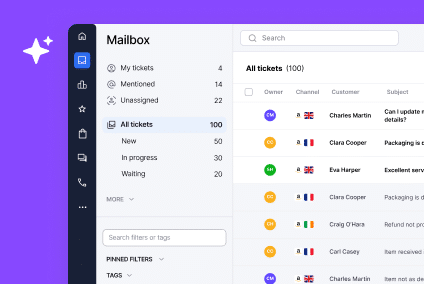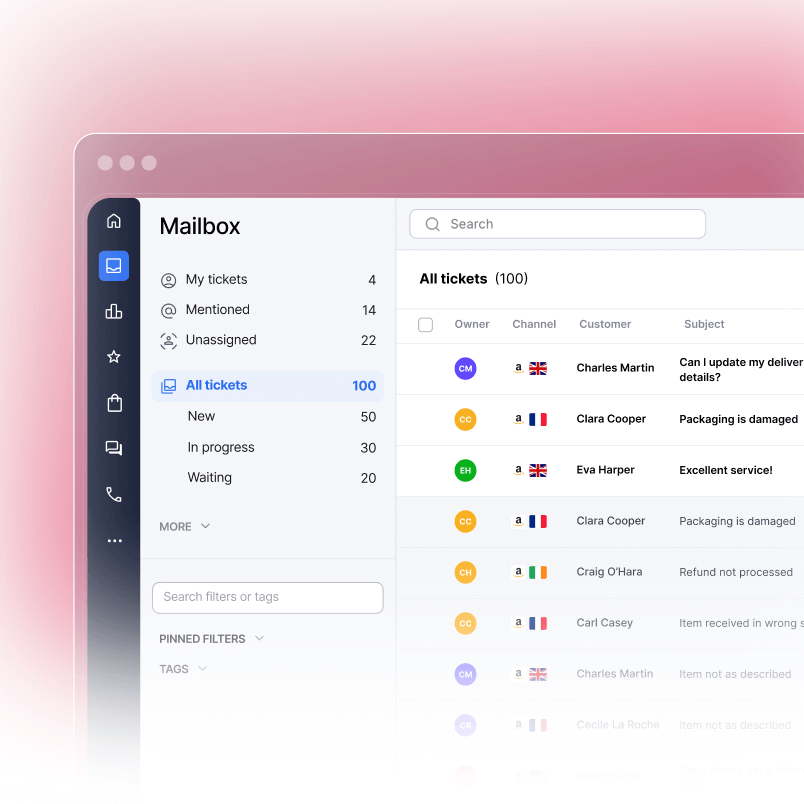Amazon’s messaging system can feel like walking a tightrope. One misstep with your response time or message content, and you risk damaging your seller account health. If you’re an Amazon seller, Virtual Assistant, or brand operator managing communications at scale, you know how critical it is to stay compliant while keeping buyers satisfied.
This guide breaks down Amazon’s messaging rules, response time SLAs, and best practices for staying ahead of compliance issues. You’ll get message templates, automation strategies, and tools to manage communications efficiently without sacrificing quality.
How Amazon’s Messaging System Works
Amazon’s messaging system lives in your Seller Central dashboard. It’s designed to facilitate communication between you and buyers, but it operates under strict rules that differ significantly from standard email.
Where to Find Messages in Seller Central
Log into your Seller Central account, then navigate to Performance tab > Messages. From here, you’ll see all buyer-initiated and seller-initiated messages. The interface shows message threads, timestamps, and your response status against Amazon’s timer. This is your control center for all buyer communication.
Types of Messages You’ll Receive
Buyer-initiated messages arrive when customers reach out about orders, shipping delays, product questions, or returns. These messages carry the most weight in Amazon’s SLA calculations. Seller-initiated messages are communications you send to buyers, though Amazon restricts what you can send. You can reach out about order confirmations, shipping notifications, or account-related issues, but promotional outreach is forbidden unless the buyer explicitly opts in.
The One-Way System Limitation
This is where sellers often stumble. Amazon’s messaging system is partially one-way. Buyers reach out to sellers through the platform, but sellers cannot initiate conversations with cold prospects or previous buyers to promote new products or services. Violating this rule results in account warnings or suspension. Messages must be in response to a buyer’s inquiry or relate directly to an existing transaction.
Message Visibility and Audit Trails
Every message in Amazon’s system is logged and audited. Amazon uses automated systems to scan message content for violations. This means every word matters. Amazon keeps detailed records of response times, message content, and resolution patterns. If an A-to-Z claim arises, Amazon reviews your entire message history with that buyer.
Amazon Message SLAs and Compliance Requirements
Amazon doesn’t publish a formal SLA document, but the platform enforces strict response time standards. Missing these deadlines directly impacts your Order Defect Rate (ODR) and seller metrics.
The 24-Hour Response Window
Amazon expects sellers to respond to buyer messages within 24 hours. This is the critical threshold. Responses received after 24 hours are flagged as late, and late responses negatively affect your ODR. For high-volume sellers, missing even one message by minutes can result in a metric violation.
Why 24 hours matters: Amazon views this as a customer service benchmark. Buyers expect fast responses, and Amazon’s algorithm rewards accounts that consistently reply within this window. Research shows that 70% of customers expect a response within 24 hours, making Amazon’s SLA aligned with broader buyer expectations. If your response time drops below 95% within a 30-day period, your seller performance rating suffers.
What You Can and Cannot Say in Messages
Allowed content includes order status updates, shipping tracking information, return instructions, refund confirmations, and troubleshooting for technical issues. You can ask clarifying questions about buyer concerns and provide product guidance tied to their specific order.
Prohibited content includes promotional messages, links to external websites (outside of Amazon), requests for positive reviews, attempts to move transactions off-platform, and emojis or excessive formatting. Amazon’s automated systems flag these instantly.
Example of compliant messaging: «Your order #123 shipped on October 20th via FedEx. Tracking number is 1Z999. Expected delivery is October 25th. Let me know if you have any other questions about this order.»
Example of non-compliant messaging: «Thanks for your purchase. Check out our store for more products and leave a great review. Here’s our external website: [link]. Get 20% off your next purchase.»
Performance Strikes and Suspension Risk
One late response won’t suspend your account. But a pattern of missed SLAs, combined with other violations, will trigger warnings and potential suspension. Amazon tracks your response time ratio monthly. If you fall below 90% within a single month, you’ll receive a performance notice.
Repeated violations over multiple months escalate the situation. First notice warns you. Second notice puts your account under review. Sustained poor performance leads to suspension.
Additionally, message violations related to content (promotional material, external links, review requests) are treated differently than late responses. One serious content violation can trigger an account suspension without the progressive warning system.
Best Practices for Faster, Compliant Messaging
Speed and compliance aren’t mutually exclusive. Here’s how to hit both targets.
Create Response Templates for Common Scenarios
Templates save time and ensure consistency. Build templates for your most frequent message types: order shipped, delivery delay, return requested, refund issued, product question, and quality concern.
Template 1 (Order Shipped):
«Your order #[ORDER_ID] has been shipped. Tracking number: [TRACKING]. Expected delivery date: [DATE]. Please let me know if you have any questions or concerns about this shipment.»
Template 2 (Delivery Delay):
«I sincerely apologize for the delay with your order #[ORDER_ID]. The carrier has been delayed, and your new estimated delivery date is [DATE]. I’m monitoring this closely and will update you immediately if there’s any change. Thank you for your patience.»
Template 3 (Return Authorized):
«Your return has been authorized under order #[ORDER_ID]. Please return the item to: [ADDRESS]. Once we receive the item, we’ll process your refund within [TIMEFRAME]. You can track your return shipment through the return label provided.»
Template 4 (Refund Processed):
«Your refund of $[AMOUNT] for order #[ORDER_ID] has been processed. It may take 5-10 business days for the funds to appear in your original payment method. Thank you for giving us the opportunity to make this right.»
Template 5 (Product Question):
«Thank you for your question about [PRODUCT_NAME]. [PROVIDE_SPECIFIC_ANSWER]. If you need any additional information, please don’t hesitate to reach out.»
Maintain a Professional Tone Across All Messages
Your tone directly affects buyer satisfaction and compliance. Stay courteous, professional, and solution-focused. Avoid defensive language, sarcasm, or emotional responses even if the buyer is frustrated.
Use «I appreciate your patience» instead of «You need to wait.» Use «I’ll help resolve this» instead of «There’s nothing I can do.» Small word choices signal care and confidence in your ability to help.
Avoid trigger words that Amazon’s system flags: «review,» «feedback,» «rate,» «five-star,» «external,» «discount,» or «click here.» These terms activate automated scans, and the system may quarantine your message for review or flag your account.
Response Timing Across Time Zones
If you operate across multiple regions, establish protocols for round-the-clock coverage. This is where Virtual Assistants and support teams become essential. Set up handoff procedures between team members to ensure messages don’t sit unread during time zone gaps.
Respond even on weekends and holidays. Amazon’s SLA timer runs 24/7. You can’t take days off from your response obligations without risking metric violations.
Archive and Organize Resolved Threads
Amazon’s interface allows you to archive messages. Move resolved conversations to archives to keep your active inbox clean and focused. This helps your team spot unanswered or urgent messages faster.
Monitor your open messages daily. Set a team routine: check messages first thing in the morning, mid-day, and end of day. This prevents threads from aging past the 24-hour window. Studies show that effective message management reduces customer service costs by up to 30% while improving satisfaction scores.
Message Templates You Can Use Today
These templates are built to be compliant, professional, and adaptable to your specific situation. Customize the bracketed sections with your order numbers, dates, and details. For more comprehensive messaging guidance, explore Amazon email templates that follow similar compliance principles.
Pre-Shipment Confirmation
«Thank you for your order #[ORDER_ID]. We’ve received your purchase and are preparing it for shipment. You’ll receive a shipping confirmation with tracking details within [TIMEFRAME]. If you have any questions before your item ships, please let me know.»
Handling Damaged or Defective Items
«I’m sorry to hear your item arrived damaged. I understand how frustrating that is. To help you quickly, I can send a replacement at no cost. Please reply with a photo of the damage so I can document this for our records. Once I receive the photo, I’ll initiate the replacement immediately. Your new item will ship within [TIMEFRAME].»
Managing Customer Expectations on Delays
«Thank you for checking on your order #[ORDER_ID]. I understand you were expecting delivery by now. The carrier has encountered unexpected delays, but your package is currently in transit. The new estimated delivery date is [DATE]. I’ll follow up with the carrier and keep you updated on any changes. I appreciate your patience.»
Addressing Quality Complaints
«Thank you for bringing this to my attention. I take quality seriously, and I want to make this right for you. I’m going to send you a replacement item at no charge. You can either keep the original item or return it to us for a full refund. Either way, you won’t pay anything additional. Your replacement will ship within [TIMEFRAME].»
Post-Delivery Follow-Up (Non-Promotional)
«Your order #[ORDER_ID] has been delivered. I hope you’re happy with your purchase. If you have any questions or concerns about the item, please reach out. I’m here to help.»
Returns and Refunds Communication
«Your return has been processed under order #[ORDER_ID]. We’ve issued a refund of $[AMOUNT]. Please allow 5-10 business days for the funds to appear in your account. Thank you for giving us the opportunity to serve you. If you have any questions about your refund, please let me know.»
Automating Amazon Messaging Without Breaking the Rules
Automation is essential for scaling, but it must be done carefully. Amazon penalizes sellers who use automation to bypass compliance rules, but it supports legitimate automation that improves efficiency. Automation in customer service can improve response times by 20-40% while reducing operational costs, when implemented correctly.
Approved Tools for Amazon Message Management
eDesk is a platform built specifically for multi-channel sellers. It integrates with Amazon and allows you to set up trigger-based responses for common scenarios. You can route messages to the right team member, apply templates quickly, and track response times in one dashboard. eDesk ensures all messages stay compliant with Amazon’s policies.
Sellerboard provides automation features within a broader analytics platform. You can create rules that assign messages to team members based on keywords or order status, reducing manual assignment work.
FeedbackWhiz offers Amazon-focused tools including message automation. The platform helps categorize incoming messages and suggests responses based on message content.
JungleScout includes messaging features within its seller toolkit. While primarily known for research, it offers basic automation for high-volume sellers.
All these tools share a common principle: they help you work faster without violating Amazon’s content policies.
How Trigger-Based Automation Works
Set up rules that respond to specific conditions. Example: if a message contains the word «shipped,» a template response suggesting they check the tracking page can be triggered. Another rule: if a message contains «damaged,» it routes to your quality team with a pre-populated template about replacement options.
The key is that you review and approve every automated response before it sends. Partial automation that flags messages for your approval is safer than fully automated sends. This approach balances speed with compliance. Many sellers combine this strategy with customer service automation to maintain consistency across multiple touchpoints and channels.
Avoiding Duplicate Replies
When multiple team members or automation systems are active, duplicate messages sometimes slip through. This looks unprofessional and wastes time. Use tools like eDesk that maintain a shared inbox and lock messages once someone begins responding. This prevents overlapping replies.
Bulk Messaging Restrictions
Amazon prohibits bulk promotional messaging to customers. You cannot use the messaging system to advertise new products to previous buyers unless they explicitly opted into marketing communications. This is a hard rule, and violations are treated seriously.
However, legitimate order-related bulk communications are acceptable. For example, if you need to notify multiple customers about a recall or a significant delay affecting their orders, this is permissible.
Monitoring Automation Logs
Review your automation activity regularly. Check which rules fired, which responses were sent, and whether any system-generated messages received complaints. Use this data to refine your automation rules and remove triggers that aren’t working well.
Tracking Metrics to Improve Your Response Strategy
Numbers tell the story of your messaging performance. Track these metrics to identify bottlenecks and opportunities.
Response Time Ratio
Calculate the percentage of messages you answer within 24 hours. Aim for 95% or higher. Track this monthly and weekly. If you see dips below 93%, dig into what happened that week. Was there an influx of orders, a team absence, or a system issue?
Formula: (Messages answered within 24 hours / Total messages received) x 100
Understanding your response time ratio directly impacts your Amazon seller metrics. This metric contributes to your overall order defect rate, which Amazon uses to rank sellers and determine account health.
Average Response Time
Beyond the binary yes/no of meeting the 24-hour window, measure your average response time. If your average is 30 minutes, you’re building buyer trust and reducing friction. If your average is 18 hours, you’re cutting it close and one spike will push you into violation territory.
Message Volume Trends
Monitor incoming message volume. Spikes during peak seasons or after promotions are normal. Prepare your team for these periods. During Black Friday or Amazon Prime Day, message volume can double or triple. Plan staffing accordingly.
Resolved vs. Pending Ratio
A resolved message means the buyer didn’t reply again after your response. A pending message sits open with no resolution. High pending ratios indicate either that your first response didn’t solve the problem or that buyers are experiencing delays getting their questions answered.
Target: 85% or higher of your messages should resolve in the first or second exchange.
Complaint Rate and A-to-Z Claims
Track how many conversations end in A-to-Z claims or buyer complaints. If a conversation leads to a claim, document what happened. Did you miss the SLA window? Did your message not address the issue? Use this feedback to adjust your approach. Quick, responsive customer service is your best defense against A-to-Z claims, as most can be prevented when sellers respond to buyer messages within 48 hours and resolve issues directly. This messaging performance directly impacts your Order Defect Rate and profitability.
eDesk Dashboard Example
eDesk provides a dashboard showing all these metrics in real-time. You can see response time performance, message volume by hour and day, team member performance, and more. This visibility allows you to make data-driven decisions about staffing, training, and process improvements.
Choosing the Right Tools for Message Management
Not all sellers need the same tool. Your choice depends on order volume, team size, and budget.
For Solo Sellers and Small Teams
If you’re managing Amazon messages yourself or with one team member, focus on tools that reduce manual work without requiring complex setup. eDesk’s pre-built templates and basic routing rules fit this profile well. Alternatively, Sellerboard’s simpler interface may appeal to you if you want straightforward categorization and assignment.
For Growing Businesses with 2-5 Team Members
As your team expands, you need tools that prevent chaos. Shared inboxes become critical. You need visibility into who’s responding to what and when. eDesk excels here because it supports team collaboration with real-time updates and prevents duplicate replies.
For Enterprise Sellers with Large Teams
Enterprise sellers require advanced analytics, complex routing rules, and integration with other systems. eDesk’s enterprise plan includes custom integrations, advanced reporting, and API access for building custom workflows.
Integration with Amazon Seller Central
The best tools integrate deeply with Amazon’s API. Look for platforms that can pull messages directly from Seller Central, log responses back to Seller Central, and maintain the audit trail Amazon expects. This eliminates manual copying and pasting of information and reduces errors. Learn more about Amazon buyer-seller messaging best practices.
Multi-Channel Consideration
If you sell on multiple platforms (eBay, Shopify, BigCommerce, Walmart), a unified inbox becomes powerful. eDesk supports most major marketplaces, allowing you to manage all customer communication in one place. This reduces context switching and improves team efficiency. Many sellers leverage multi-channel fulfillment strategies to expand their reach, which demands integrated messaging tools to stay organized and compliant across platforms.
Master Your Messaging, Master Your Sales
Amazon’s messaging system isn’t complicated once you understand the rules. The 24-hour window, compliant content, and consistent responses are the foundation. Build on that foundation with templates, automation, and the right tools, and you’ll see your metrics improve, your A-to-Z claims drop, and your buyer satisfaction soar.
Every message is an opportunity to turn a satisfied buyer into a repeat customer. Every response time you nail is a vote of confidence in your brand. The sellers who win on Amazon aren’t the ones cutting corners on communication. They’re the ones who automate smartly and respond fast.
Ready to take control of your messaging workflow? Start using eDesk free today and see how automation and shared inboxes transform your response times and team efficiency. Your 24-hour SLA will thank you.
FAQs
What is the Amazon buyer-seller message SLA?
Amazon expects sellers to respond to buyer messages within 24 hours. Responses after this window are flagged as late and negatively impact your Order Defect Rate (ODR) and seller performance rating.
What happens if I don’t reply within 24 hours?
Late responses are logged against your monthly response time ratio. If you fall below 90% within a month, Amazon sends a performance notice. Repeated violations over multiple months escalate warnings and can lead to account suspension.
Can I automate Amazon messages?
Yes, you can use approved automation tools like eDesk, Sellerboard, FeedbackWhiz, and JungleScout. These tools allow trigger-based responses and message routing. However, Amazon prohibits fully automated promotional messaging. All automation should comply with Amazon’s content policies.
Are emojis allowed in Amazon messages?
No. Amazon discourages emojis in buyer-seller messages. Stick to professional, plain text communication. Excessive formatting is also flagged by Amazon’s systems.
Can I send promotional messages to past customers?
No. Amazon prohibits unsolicited promotional messaging. You cannot use the messaging system to advertise new products to previous buyers unless they explicitly opted into marketing communications. This applies even if they purchased from you before.
Can I include external links in messages?
Amazon restricts external links in buyer-seller messages. Links to tracking pages or Amazon product pages are sometimes acceptable within context, but links to external websites, coupon sites, or your own store are prohibited.
What should I do if a buyer complains about a late response?
Document the complaint and investigate why the response was late. If it was a system issue or team oversight, acknowledge it and take corrective action. Use this as a training opportunity for your team to prevent future delays.
How do I track my response time ratio?
Most marketplace management tools like eDesk provide real-time dashboards showing your response time ratio. You can also log into Seller Central and view your monthly performance metrics under the Performance tab.
What if I have multiple sellers or team members responding to messages?
Use a shared inbox tool that prevents duplicate replies and logs activity. eDesk and similar platforms allow multiple team members to access the same message queue while maintaining a clear audit trail of who responded when.
Is there a fee for using Amazon’s messaging system?
No. Amazon’s messaging system is free for all sellers. However, third-party tools that enhance messaging management (like eDesk) charge subscription fees based on features and usage.
How can I improve my response time?
Build response templates for common scenarios, set up automation rules to flag priority messages, schedule team coverage across time zones, and establish a daily routine where your team checks messages multiple times per day. Tools like eDesk also provide alerts for messages approaching the 24-hour window.
What types of messages must I respond to?
You must respond to all buyer-initiated messages about orders. This includes questions about shipping, product issues, returns, refunds, and product specifications. You’re not obligated to respond to abusive or off-topic messages, but contacting Seller Support is the right channel for handling those situations.




